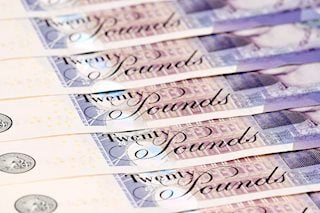GBP/USD ticks higher to 1.3025 area on softer USD, BoE rate-cut bets cap gains
|
- GBP/USD recovers further from a two-month low, albeit the upside potential seems limited.
- The USD bulls opt to take some profits off the table, which, in turn, lends support to the pair.
- An unexpected fall in the UK inflation reaffirms bets for more BoE rate cuts and caps the GBP.
The GBP/USD pair attracts some follow-through buying during the Asian session on Friday and looks to build on the overnight bounce from the 1.2975-1.2970 region, or a two-month low. Spot prices currently trade around the 1.3020-1.3025 area, up 0.10% for the day amid a modest US Dollar (USD) downtick, though any meaningful appreciating move still seems elusive.
The USD Index (DXY), which tracks the Greenback against a basket of currencies, pulls back from its highest level since early August as traders opt to take some profits off the table following a strong rally since the beginning of this month. That said, growing acceptance that the Federal Reserve (Fed) will proceed with modest rate cuts over the next year should limit the USD losses and cap the GBP/USD pair.
Furthermore, a surprise fall in the UK Consumer Price Index (CPI) to the lowest level since April 2021 and below the Bank of England's 2% target paves the way for further interest rate cuts. In fact, the money markets are now pricing in over a 90% chance that the UK central bank will lower borrowing costs by 25 basis points (bps) at its upcoming meeting in early November and cut rates again in December.
This might further hold back traders from placing aggressive bullish bets around the British Pound (GBP) and contribute to keeping a lid on the GBP/USD pair. Hence, it will be prudent to wait for strong follow-through buying before confirming that the recent retracement slide from the 1.3435 region, or the highest level since March 2022 touched last month has run its course and positioning for further gains.
Traders now look to the release of UK Retail Sales for some impetus ahead of the US housing market data – Building Permits and Housing Starts later during the early North American session. This, along with Fed Governor Christopher Waller's speech, will influence the USD and produce short-term opportunities around the GBP/USD pair, which seems poised to register losses for the third successive week.
Pound Sterling FAQs
The Pound Sterling (GBP) is the oldest currency in the world (886 AD) and the official currency of the United Kingdom. It is the fourth most traded unit for foreign exchange (FX) in the world, accounting for 12% of all transactions, averaging $630 billion a day, according to 2022 data. Its key trading pairs are GBP/USD, also known as ‘Cable’, which accounts for 11% of FX, GBP/JPY, or the ‘Dragon’ as it is known by traders (3%), and EUR/GBP (2%). The Pound Sterling is issued by the Bank of England (BoE).
The single most important factor influencing the value of the Pound Sterling is monetary policy decided by the Bank of England. The BoE bases its decisions on whether it has achieved its primary goal of “price stability” – a steady inflation rate of around 2%. Its primary tool for achieving this is the adjustment of interest rates. When inflation is too high, the BoE will try to rein it in by raising interest rates, making it more expensive for people and businesses to access credit. This is generally positive for GBP, as higher interest rates make the UK a more attractive place for global investors to park their money. When inflation falls too low it is a sign economic growth is slowing. In this scenario, the BoE will consider lowering interest rates to cheapen credit so businesses will borrow more to invest in growth-generating projects.
Data releases gauge the health of the economy and can impact the value of the Pound Sterling. Indicators such as GDP, Manufacturing and Services PMIs, and employment can all influence the direction of the GBP. A strong economy is good for Sterling. Not only does it attract more foreign investment but it may encourage the BoE to put up interest rates, which will directly strengthen GBP. Otherwise, if economic data is weak, the Pound Sterling is likely to fall.
Another significant data release for the Pound Sterling is the Trade Balance. This indicator measures the difference between what a country earns from its exports and what it spends on imports over a given period. If a country produces highly sought-after exports, its currency will benefit purely from the extra demand created from foreign buyers seeking to purchase these goods. Therefore, a positive net Trade Balance strengthens a currency and vice versa for a negative balance.
Information on these pages contains forward-looking statements that involve risks and uncertainties. Markets and instruments profiled on this page are for informational purposes only and should not in any way come across as a recommendation to buy or sell in these assets. You should do your own thorough research before making any investment decisions. FXStreet does not in any way guarantee that this information is free from mistakes, errors, or material misstatements. It also does not guarantee that this information is of a timely nature. Investing in Open Markets involves a great deal of risk, including the loss of all or a portion of your investment, as well as emotional distress. All risks, losses and costs associated with investing, including total loss of principal, are your responsibility. The views and opinions expressed in this article are those of the authors and do not necessarily reflect the official policy or position of FXStreet nor its advertisers.